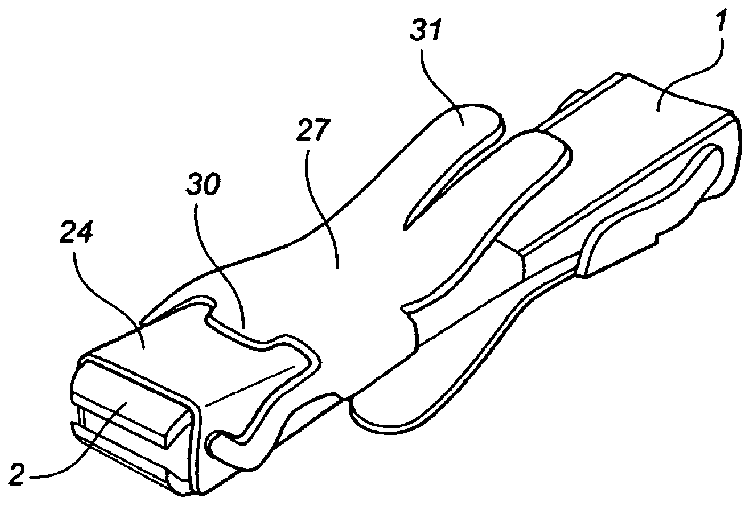
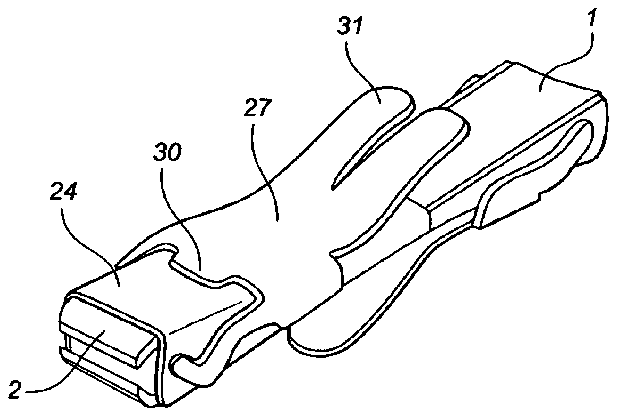
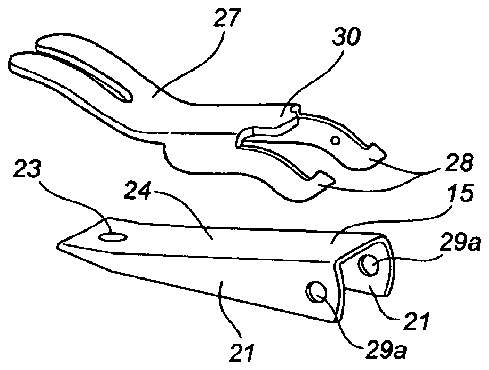
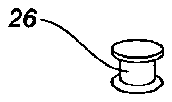
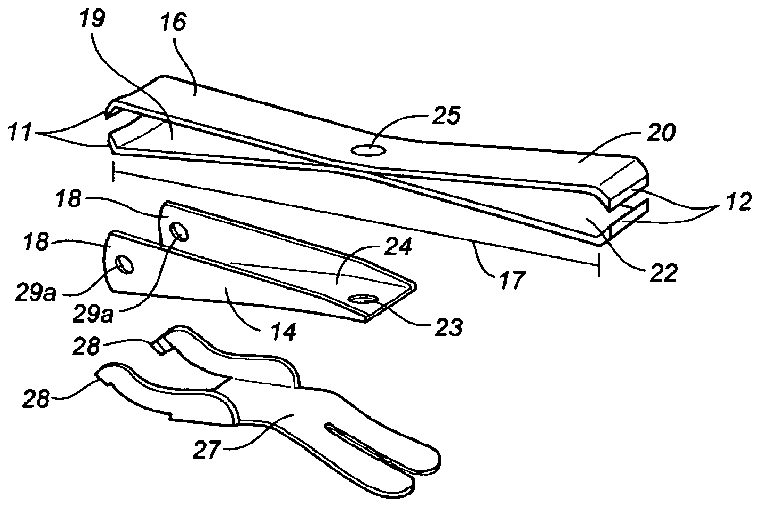
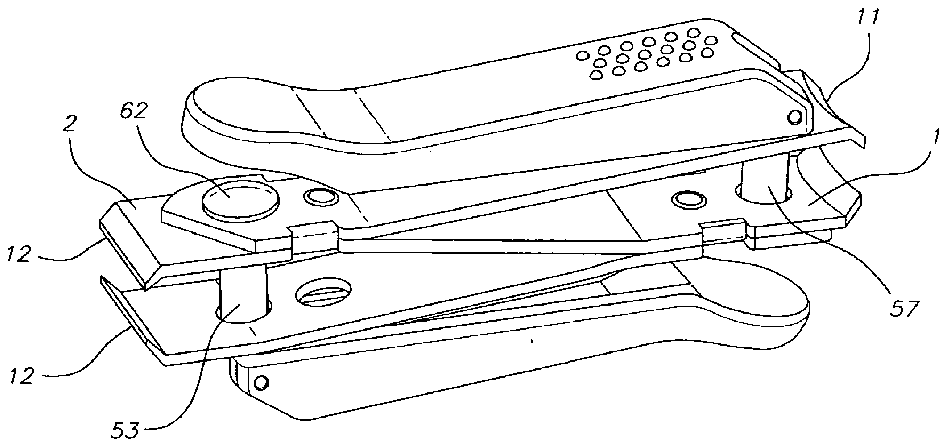
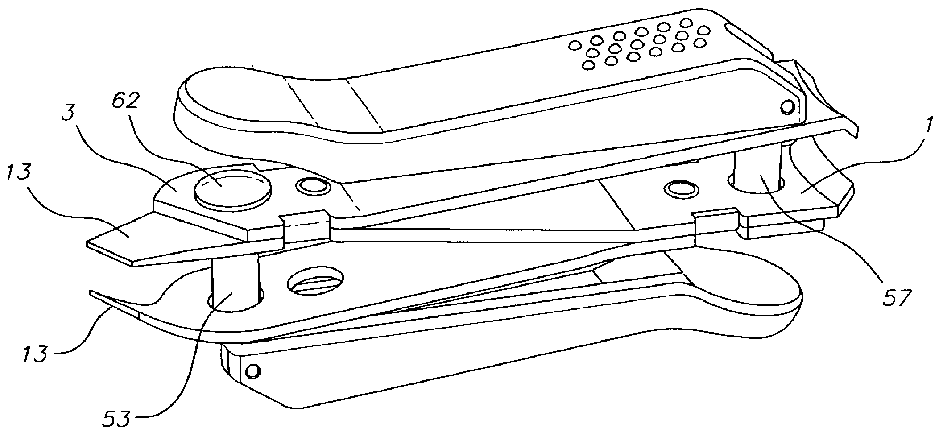
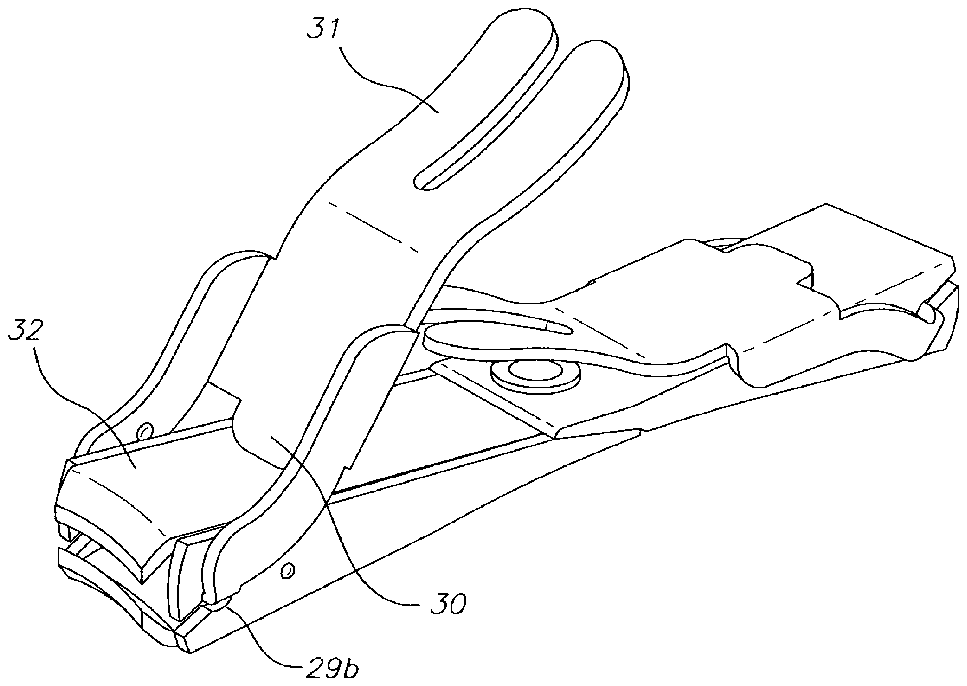
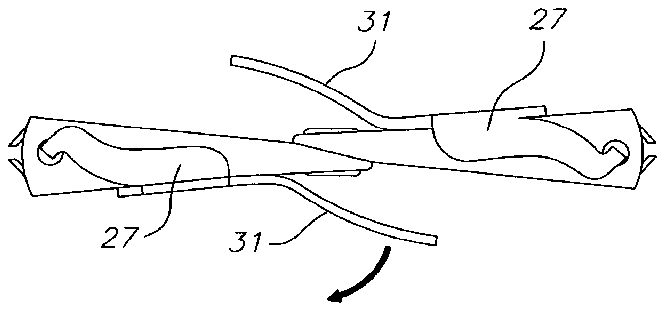
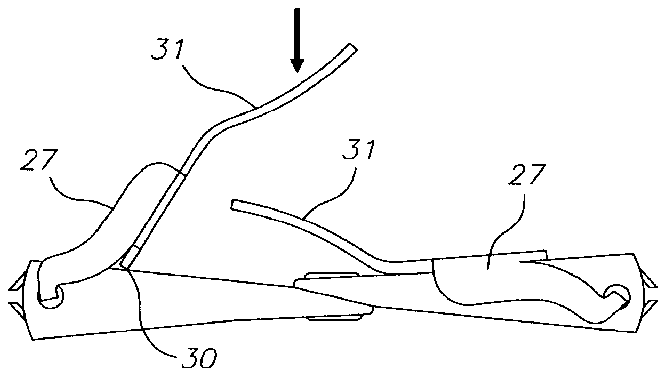
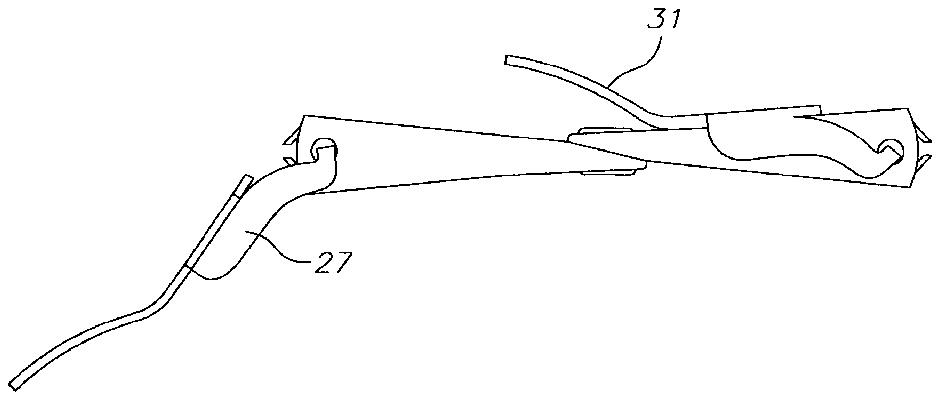
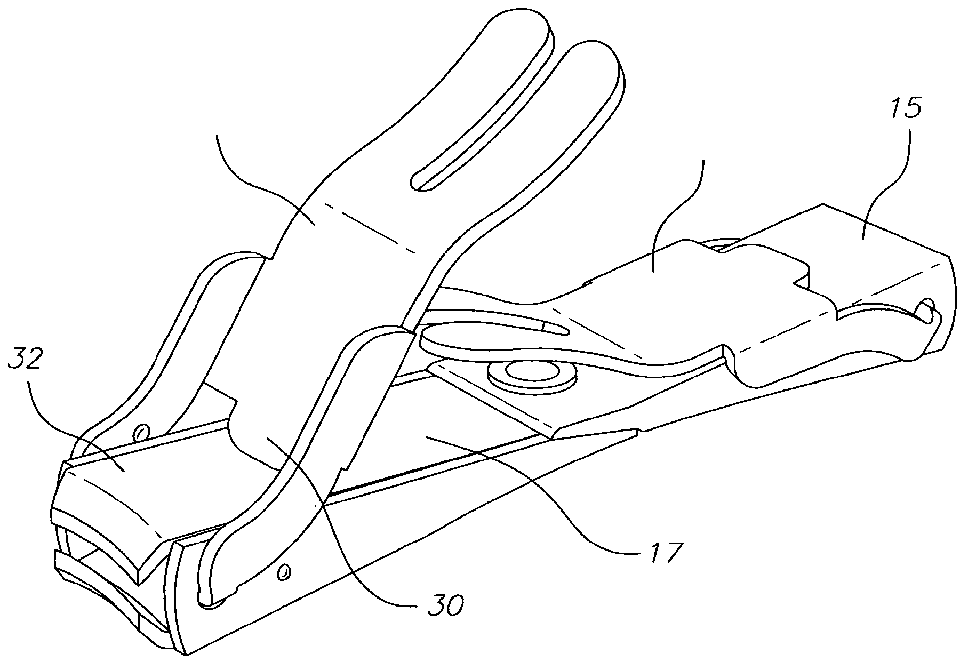
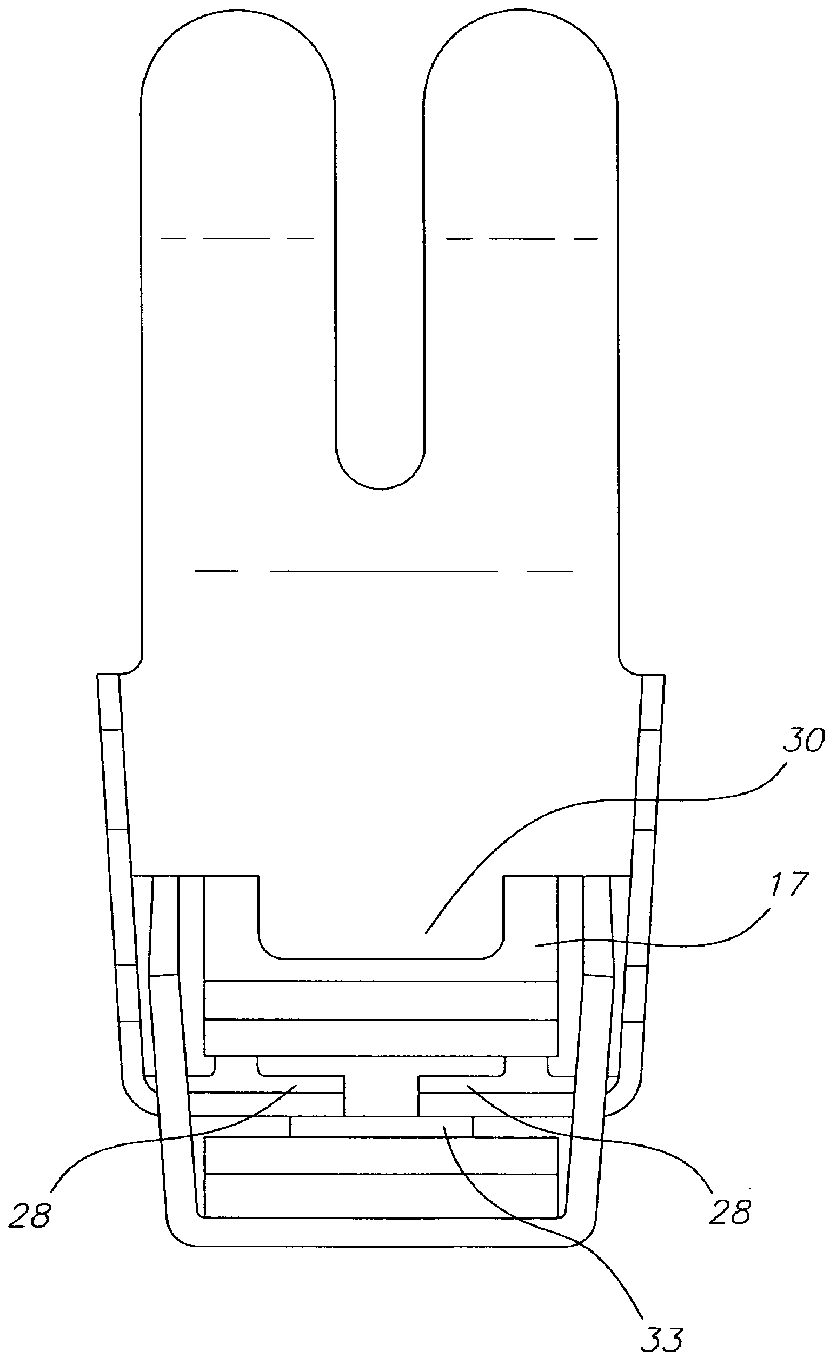
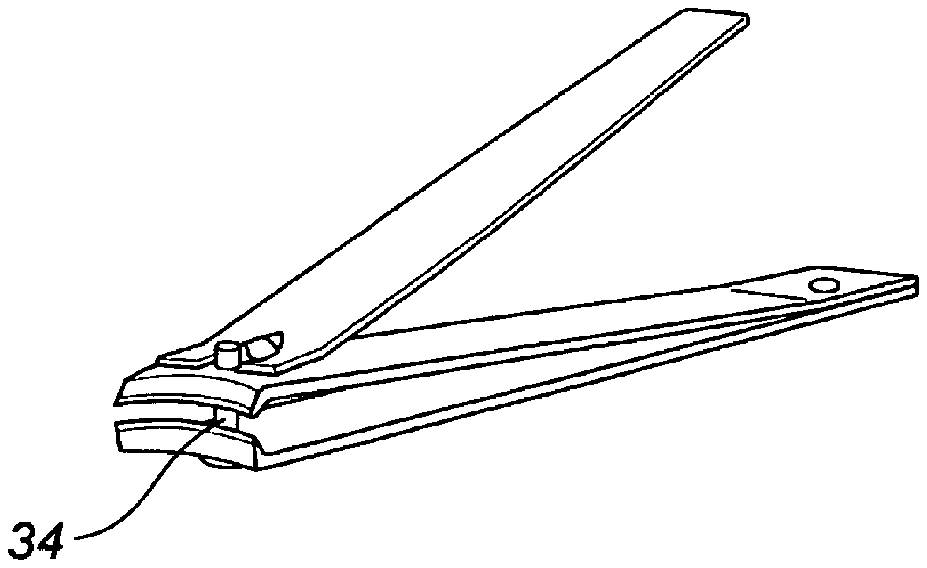
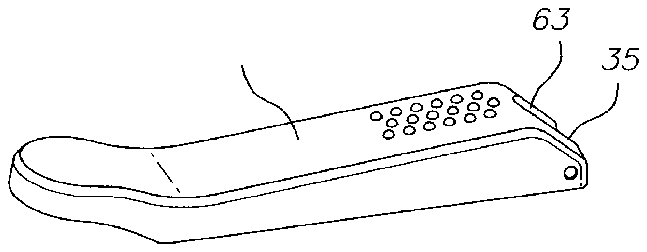
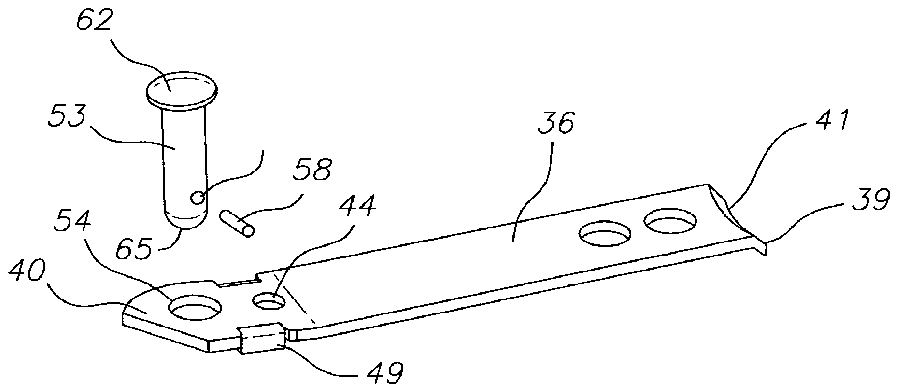
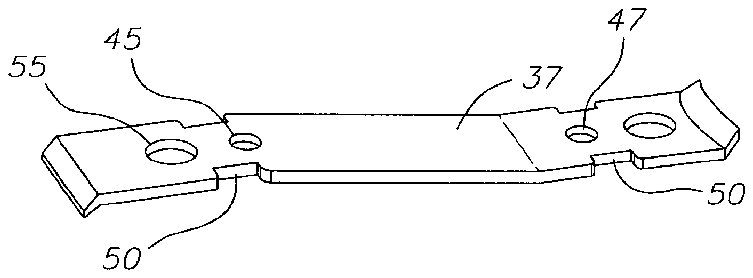
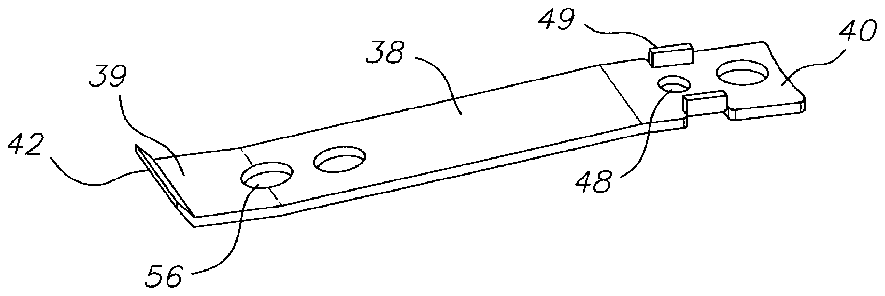
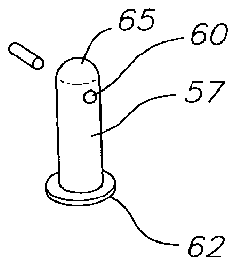
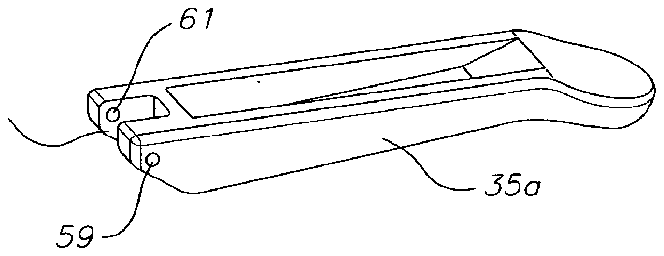
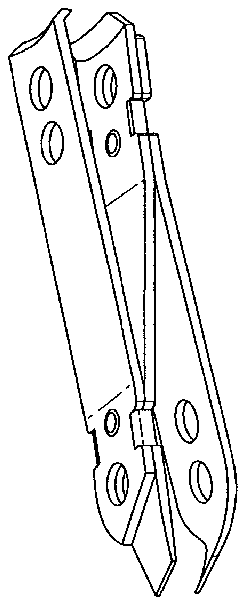
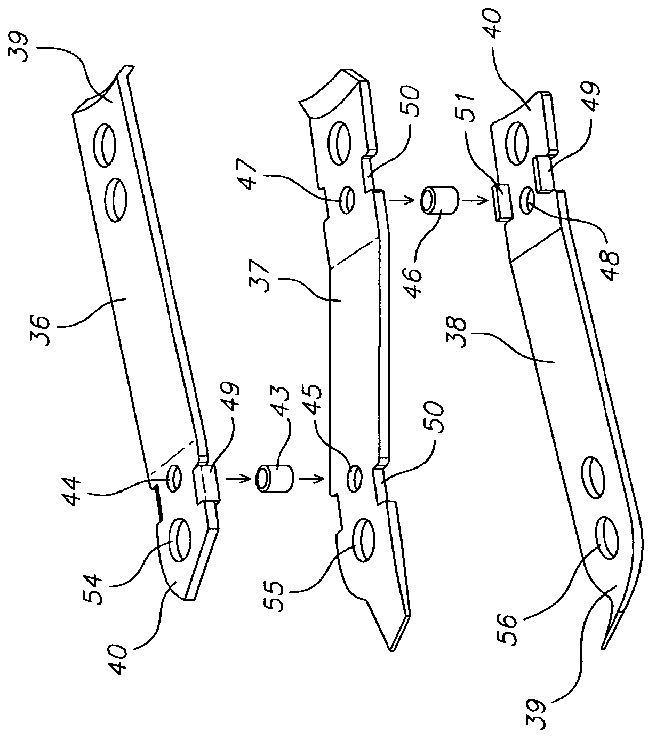
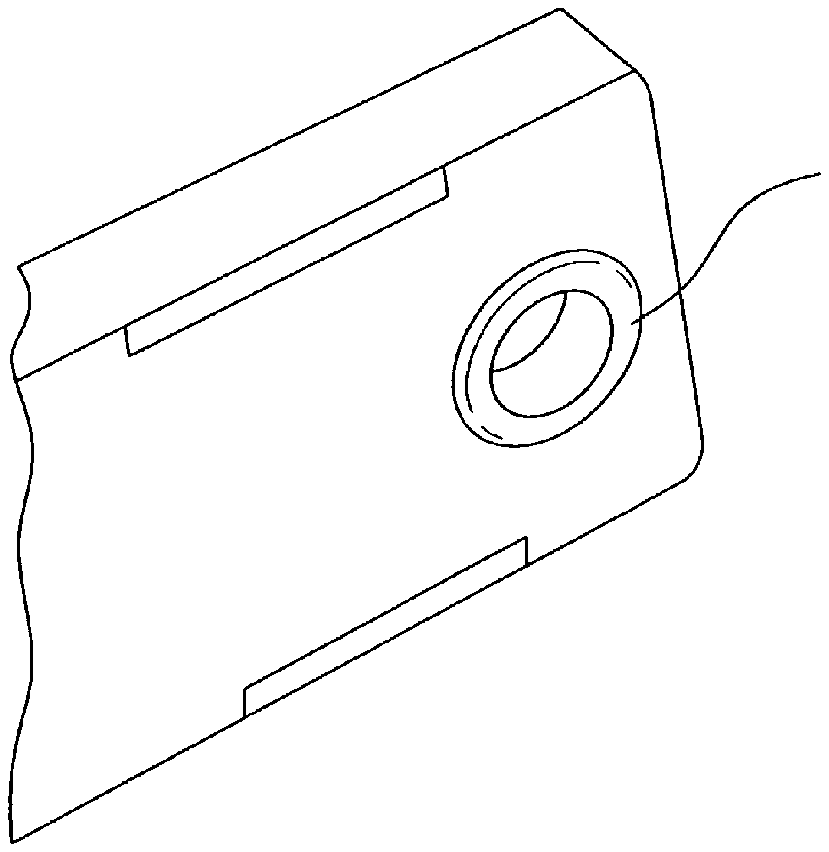
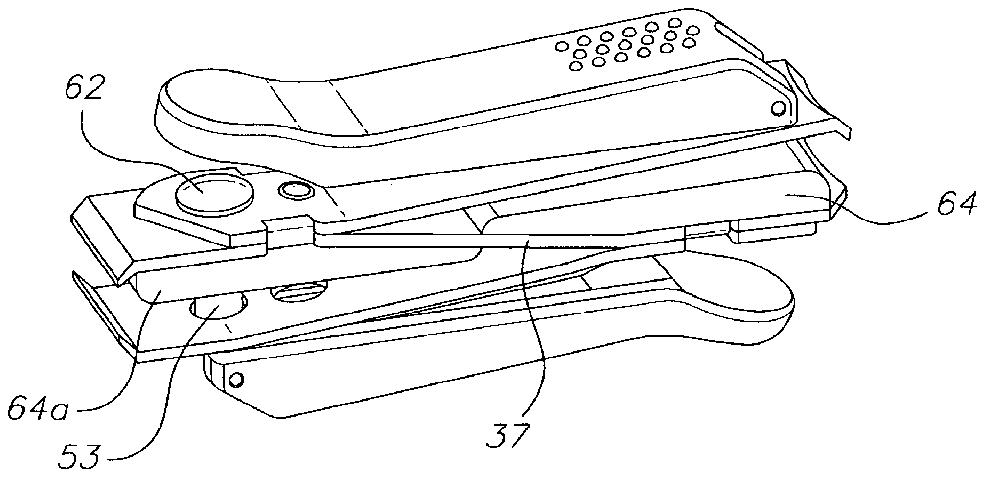
- 1finger nail cutter
- 2toe nail cutter
- 3cuticle trimmer
- 11cutting blades
- 13or 12 or
- 14clip cover
- 15second clip cover
- 16one end
- 17planar double clipper body
- 18lateral sides
- 19lateral sides
- 20other end
- 21lateral sides
- 22lateral sides
- 24clip cover base
- 25central opening
- 26tubular rivet
- 27lever arm
- 28prongs
- 29openings
- 30pressing end section
- 31raised platform
- 32surface
- 33raised plate
- 34usual pin
- 35handles
- 36first clipper plate
- 37common clipper plate
- 38second clipper plate
- 39one edge or end
- 40non-bladed end
- 41cutting blade
- 42cutting blade
- 43rivet
- 44opening
- 45opening
- 46rivet
- 47opening
- 48opening
- 49angular flanges
- 50angular notches
- 52assembled clipper body
- 53lever pin
- 54openings
- 57lever pin
- 58pin key
- 59pin hole
- 60pin key hole
- 61pin hole
- 62head
- 63etched out section
- 65opposite end
- 100double ended clipper
- 180lever pin 57 approximately
Abstract
A double ended clipper, comprising a double clipper body having two opposite cutting members with a pair of cutting blades, in a planar or a stacked position. The cutting members can have clip covers covering both lateral sides of the cutting members with the clip cover leaving the cutting blades exposed. The double ended clipper is operated by a lever arm attached to the clip cover or by a handle attached to the cutting members in a similar manner as the conventional nail cutters.
Description
[0001] This invention relates to a device having two cutting members in a planar or stacked arrangement.
BACKGROUND
[0002] The double ended clipper will be applied here for beauty implements, for example, nail and cuticle cutters which would require different types of blades. In current practice, one carries or uses multiple nail cutters also known as nail clippers, one for cutting the toe nails and one for cutting the finger nails. Toe nails are the nails of the foot and finger nails are the nails of the hand. The nail cutter for the toe nails, herein referred to as toe nail cutter, usually have bigger blades than the nail cutter for the fingers, herein referred to as finger nail cutter. Also, the toe nails are usually thicker than the finger nails, necessitating two types of nail cutters. Further, nail cutters can have two kinds of blades, a straight shaped blade and a curved shaped blade. The straight shaped blades are usually placed on the toe nail cutters because the toe nails have a tendency to penetrate into the skin if cut with a curved blade which can result into an inflammation. Straight shaped blade for finger nails are usually used when the person prefers the finger nails to have a straight tip. It is also hygienic to separate the cutting members. For example, the toes are more likely to harbor microorganisms because the feet are most of the time enclosed inside a shoe for long period of hours in contrast with the finger nails which are exposed to the atmosphere most of the time. Further, using toe nail cutters to cut the finger nails does not allow one to easily and properly cut the finger nails to the desired shape and at times have caused accidental clipping of the skin around the finger nails because of the size and/or shape of the blade compared to that of the finger nails. For the reasons stated above, one usually have or carries at least two nail cutters, one for the toe nails and one for the finger nails. Carrying two nail cutters is not only bulkier but also inconvenient. A cuticle trimmer, like the other cutters, requires a different pair of cutting blades. This is usually carried as a separate device. The same can be said for the other types of cutting members having different types of blades other than the ones used here as example.
[0003] It is therefore an object of this invention to provide a double ended clipper or cutter having two cutting members with different types of blades of varying sizes and shapes.
[0004] It is also an object of this invention to provide a multiple cutting device in a single portable piece.
[0005] It is also a further object of this invention to provide a two in one type of cutting device that is easier to manufacture and at a cost lower than manufacturing separate cutting devices.
[0006] It is also still a further object of the invention to manufacture multiple cutting members with less amount of raw materials thereby conserving on the usage of these materials.
SUMMARY OF THE INVENTION
[0007] This invention is directed to a double ended clipper, comprising a double clipper body having two opposite cutting members on each end, each with a pair of cutting blades, in a planar position; a clip cover on each cutting member covering both lateral sides of the cutting members, the clip cover leaving the cutting blades exposed; a lever arm attached to each clip cover for operating the cutting members; means for attaching the lever arm to the clip cover; and, means for attaching the double clipper body to the clip cover. The cutting members have different types of cutting blades. One design has the cutting members fused together at a mid location while another design attaches two separate cutters together at a mid section of the double ended clipper. One means for attaching the double clipper body to the clip cover of the cutting members is a tubular rivet introduced through aligned openings of the clip covers and a central opening aligned with the aligned openings of the clip covers on the double clipper body. The lever arm has a first end and a second end, the first end having a prong on each side inserting into a pair of matching openings on the clip cover and a clipper pressing end section opposite a raised platform, the raised platform located at the second end of the lever arm. Examples of matching openings are circular or a slit with a circular end. The double ended clipper can have a raised plate at an inside surface of the double clipper body. The raised plate provides a resting platform for the prongs of the lever arm when the clipper pressing end section press on the double clipper body of the double ended clipper. The lever arm swings from a keeping position to a working position as the prongs pivot around the matching openings on the clip cover. The lever arm in the working position has a raised platform higher than a raised platform of the lever arm in the keeping position.
[0008] Another design is to stack the cutting members on top of each other. This double ended clipper, comprises an assembled clipper body having two cutting members, a top cutting member stacked on top of a bottom cutting member, each cutting member opposite each other having a pair of cutting blades; a first handle for the top cutting member and a second handle for the bottom cutting member; means for assembling the clipper body; and, means for connecting the first handle to the top cutting member and the second handle to the bottom cutting member. The cutting members can have different types of cutting blades. The assembled clipper body has a first clipper plate, a common clipper plate, and a second clipper plate. The first and second clipper plates have one of the pair of cutting blades on one end and a non-bladed end opposite the cutting blade. The cutting blade of the first clipper plate is at a position opposite the cutting blade of the second clipper plate. The common clipper plate has a cutting blade at both ends of the plate, with one cutting blade pairing with the cutting blade on the first clipper plate and the other cutting blade pairing with the cutting blade of the second clipper plate. One way for assembling the clipper body is a first rivet having one end inserted into an opening at a non-bladed end of the first clipper plate and the other end inserted into an opening on one end of the common clipper plate at the same side of the opening at the non-bladed end of the first clipper plate and a second rivet having one end inserted into an opening at the common clipper plate and the other end inserted on an opening at a non-bladed end of the second clipper plate at the same side of the opening at the common clipper plate, the first and second rivets press punched to form a lip around the rim of the openings thereby connecting the first and second clipper plates with the common clipper plate. The connection between the first and second clipper plates with the common clipper plate can be reinforced by angular flanges engaging with angular notches. One way of connecting the handles to the top and bottom cutting members are by lever pins. The stacked double ended clipper can also have a clip cover for each cutting member. One example are side bars extending upwards from both lateral sides of the common clipper plate for the top cutting member and side bars extending downwards from both lateral sides of the common clipper plate for the bottom cutting member. Like the double ended clipper in a planar position, the stacked double ended clipper can also use a lever arm attached to the clip cover to operate the double ended clipper instead of the handles. The method of attaching the lever arm to the clip cover has been amply described for the planar double ended clipper and will not be reiterated for the stacked double ended clipper.
[0009] Other embodiments of the present invention will become readily apparent to those skilled in the art from the following detailed description, wherein it shows and describes only certain embodiments of the invention by way of illustration. As will be realized, the invention is capable of other and different embodiments and its several details are capable of modification in various other respects, all without departing from the spirit and scope of the present invention. Accordingly, the drawings and detailed description are to be regarded as illustrative in nature and not as restrictive.
BRIEF DESCRIPTION OF THE DRAWING
[0010] Aspects of the present invention are illustrated by way of example, and not by way of limitation, in the accompanying drawings, wherein:
[0011] FIG. 1 is a perspective view of a double ended nail clipper in a planar orientation.
[0012] FIG. 1A is a perspective view of a double ended nail clipper in a stacked orientation.
[0013] FIG. 1B is a perspective view of a double ended clipper having a combination of a cuticle trimmer and a nail cutter in a stacked orientation.
[0014] FIG. 2 show the components of an example of a planar double ended clipper shown in FIG. 1 .
[0015] FIG. 2A show a slit opening with a circular end instead of a circular opening on the sides of a clip cover.
[0016] FIG. 3 is a side view of the planar double ended clipper shown in FIG. 1 with both lever arms in a keeping position.
[0017] FIG. 4 is a side view of the planar double ended clipper with one lever arm in a working position and the other lever arm in a keeping position.
[0018] FIG. 4A is a perspective view of the planar double ended clipper of FIG. 4 showing how the lever arm in a working position presses on the clipper body.
[0019] FIG. 5 is a side view of the planar double ended clipper with one lever arm at the intermediate swinging position and the other lever arm in a keeping position.
[0020] FIG. 6 is a front view of one clipper showing the interior of the clipper body.
[0021] FIG. 7 is a perspective view of a prior art nail cutter.
[0022] FIG. 8 show the components of an example of a stacked double ended clipper shown in FIG. 1A .
[0023] FIG. 9 show the assembly of the clipper body for the stacked double ended clipper.
[0024] FIG. 10 show the lip formed around an opening when a rivet is press punched to connect parts together.
[0025] FIG. 11 is a side view of a stacked double ended clipper with clip covers for the cutting members.
DETAILED DESCRIPTION OF THE INVENTION
[0026] The detailed description represented herein is not intended to represent the only way or the only embodiment in which the claimed invention may be practiced. The description herein is provided merely as an example or examples or illustrations of the claimed invention and should not be construed as the only way or as preferred or advantageous over other embodiments or means of practicing the invention. Any cutters or cutting members with different cutting blades constructed in a single body or in one piece is within the scope of this invention. The detailed description includes specific details to provide a thorough understanding of the claimed invention and it is apparent to those skilled in the art that the claimed invention may be practiced without these specific details.
[0027] FIG. 1 is a perspective view of a double ended clipper 100 in a planar orientation, hereinafter planar double ended clipper, having one type of clipper, usually a finger nail cutter 1 shown better in FIG. 2 , on one end and another type of clipper, usually a toe nail cutter 2 , on the other end. A cuticle trimmer 3 instead of a nail cutter can be combined with the other nail cutter in either a planar or stacked position as shown in FIG. 1B . The above cutters will be used as examples to describe the design and construction of the double ended clipper but it should be understood that other cutters can also be constructed similarly.
[0028] Since there are a few types of clippers, there are also several cutting members that can be used depending upon the desired application, for example, shown here are cutting members having a pair of cutting blades 11 for the finger nail cutter, 12 for the toe nail cutter and 13 for the cuticle trimmer. Other cutting members not shown here may also be constructed in the planar or stacked position. The planar double ended clipper may be constructed from two clippers or cutting members fused together at a mid location or it may be assembled from two separate pieces of clippers attached together at a mid section. FIG. 2 shows the components of the planar double ended clipper 100 with two cutting members fused together as a single piece or body at a mid location, also referred to herein as planar double clipper body. The components of the double ended clipper 100 shown in FIG. 2 comprises a first clip cover 14 for the cutting member 11 of a first nail cutter and a second clip cover 15 for the cutting member 12 of a second nail cutter. A clip cover 14 is placed on one end 16 of the planar double clipper body 17 with the lateral sides 18 of the clip cover 14 covering the lateral sides 19 on one end of the double clipper body 17 . A second clip cover 15 is placed on the other end 20 of the planar double clipper body 17 in the same manner as the clip cover 14 , with the lateral sides 21 of the second clip cover covering the lateral sides 22 on the other end of the double clipper body 17 . The clip cover leaves the top side of the cutting member it covers exposed, consequently, the pair of cutting blades. Each clip cover has an opening 23 on one end of the clip cover base 24 . These openings on the respective clip covers are aligned with a central opening 25 on the planar double clipper body 17 . After aligning the openings 23 and 25 , a tubular rivet 26 is introduced into these openings to hold the clip covers and the double clipper body together. Other fastening means are known in the art. The cutting members at opposite ends of the double ended body 17 as shown in FIG. 2 are normally open at an angle to allow the nails to be cut to go through. A lever arm 27 is attached to each clip covers, 14 and 15 for the operation of the cutting members and consequently, the cutters, as shown in FIGS. 1 , 3 and 4 . The lever arms 27 as shown are usually in opposite orientation and spatial location to keep them from interfering with each other and to keep the length of the device as short as possible. Each lever arm 27 has two ends, a first end and a second end. The lever arms are identical to each other. The first end of the lever arm has two prongs or a pair of protrusions 28 , hereinafter also referred to simply as prongs, for insertion into a matching pair of openings 29 on the lateral side of the clip cover. Instead of a circular opening 29 a as shown here, this may be a pair of slits cutting into the front edge of the lateral sides of the clip covers with a circular end 29 b through which the two prongs 28 inserts into. FIG. 4A shows a circular opening while FIG. 2A shows the slit with a circular end. Openings 29 a and 29 b are hereinafter collectively referred to simply as openings 29 . These openings are recommended to be circular at the area where the prongs 28 pivot around when the lever arm 27 swings from a keeping position as shown in FIGS. 1 and 3 to a working position as shown in FIG. 4 by one of the lever arms. FIG. 5 shows a lever arm 27 at an intermediate swinging position prior to positioning into the working position shown in FIG. 4 . Each lever arm has a clipper pressing end section 30 opposite a raised platform 31 located at the second end of the lever arm. When the lever arm is in the working position, the front tip of the pressing end section 30 abuts on the top surface 32 of the exposed planar double clipper body 17 with the raised platform of the lever arm in the working position higher than the raised platform of the lever arm in the keeping position as shown in FIGS. 2A and 4A . To cut the nails or trim a cuticle, the fingers except the thumb are positioned at the bottom surface of the double ended clipper with the thumb positioned on top of the raised platform 31 . The thumb presses on the raised platform which consequently translates this motion to the pressing end section 30 . The pressing end section then presses on the exposed surface 32 of the clipper body 17 to cause the cutting member or pair of cutting blades 11 , or 12</span> or 13 to come together and consequently cut any object in between the pair of cutting blades. Note that the top surface of the raised platform at the keeping position becomes the bottom surface after swinging the lever arm to the working position. Note also as shown in FIGS. 4 and 4A that the raised platform of the lever arm at the working position, hereinafter the working lever arm, is way on top of the other raised platform of the lever arm at the keeping position, hereinafter the keeping lever arm, thereby allowing the raised platform of the working lever arm to move up or down during the cutting operation without obstruction from the raised platform of the keeping lever arm. In using the double ended clipper 100 , one of the lever arms is usually at the working position while the other lever arm is at the keeping position, although it is also possible to operate the device with both lever arms in the working position. As shown, the raised platform can also have a curve outer surface to accommodate and allow the thumb to comfortably press on the said surface. A raised plate 33 can be placed at an inside surface of the double clipper body where the prongs 28 can rest on when the pressing end section 30 presses on the double clipper body 17 as shown in FIG. 6 .
[0029] The planar double ended clipper has a double ended clipper body 17 that does not have the usual pin 34 situated between the top and bottom blades of the cutting members as shown in FIG. 7 . Consequently, it is easy for the loose cut nails or cuticles to exit the clipper and temporarily lodge inside the clip cover before being discarded after the cutting operation. The absence of the pin also makes the construction and operation of the clipper simpler.
[0030] Instead of the double ended clipper in a planar position, the cutting members can also be stacked on top of each other as shown in FIG. 1A . As in the planar double ended clipper, the cutting members can have a variety of cutting blades of different shapes to suit a particular usage or the kind of object to be cut. FIG. 8 shows the components of an example of a stacked double ended clipper 100 . There are two identical handles 35 , one for the bottom, 35 a, and one for the top, 35 b, of the stacked cutting members, herein also referred to as the assembled clipper body of the stacked double ended clipper. The assembled clipper body is made up of a first clipper plate 36 , a common clipper plate 37 , and a second clipper plate 38 . The first and second clipper plates have one of the pair of cutting blades on one edge or end 39 with a non-bladed end 40 opposite the cutting blade. The cutting blade on the first clipper plate 36 is at a position opposite the cutting blade on the second clipper plate 38 . The common clipper plate 37 has a cutting blade on both ends or edges of the plate, one pairing with the cutting blade 41 on the first clipper plate 36 and the other pairing with the cutting blade 42 of the second clipper plate 38 . FIG. 9 shows how the two clippers or cutting members are assembled. One end of a first tubular rivet 43 is inserted into an opening 44 on the non-bladed end of the first clipper plate 36 and the other end is inserted into an opening 45 on one end of the common clipper plate 37 at the same side of the opening 44 . After insertion, the rivet 43 is press punched to form a lip as shown in FIG. 10 around the rim of opening 44 and opening 45 , thereby connecting the first clipper plate with the common clipper plate. A second tubular rivet 46 is used to connect the common clipper plate 37 with the second clipper plate 38 . As with the first rivet 43 , one end of the second rivet 46 is inserted into opening 47 on the common clipper plate 37 and the other end is inserted on an opening 48 at the non-bladed end of the second clipper plate 38 at the same side of opening 47 . This rivet 46 is also press punched to connect the common clipper plate with the second clipper plate 38 .
[0031] The inter-connected plate 52 is shown at the right of the arrow of FIG. 9 . Angular flanges 49 engaging with angular notches 50 on both sides of the plates reinforces the connections of the common clipper plate with the first and second clipper plates. This assembled clipper body 52 of the stacked double ended clipper is connected to the top and bottom handles 35 a and 35 b by inserting a lever pin 53 on one end through openings 54 , 55 , and 56 . The lever pin 53 connects the assembled clipper body 52 to the bottom handle 35 a while the another lever pin 57 connects the assembled clipper body to the top handle 35 b. To keep the connections with the handles permanent, a pin key 58 is inserted into a pin hole 59 of one handle, through a bored-through pin key hole 60 at a location near one end of a lever pin and then through another pin hole 61 of the same handle opposite the pin hole 59 . Further, the lever pin has a head 62 opposite the end having the pin key hole 60 to reinforce the connection. As shown in FIGS. 8 and 11 , the head 62 of each lever pin 53 and 57 situates on the surface of the first and second clipper plates while the opposite end 65 having the pin key hole 60 situates in an etched out section 63 at a front end of the handles. This connection is the same for both top and bottom handle. This connection allows the respective handles to switch from a keeping position as shown in FIGS. 1A , 1 B, and 11 to a working position by turning the handles around the lever pin 57 approximately 180 degrees and flipping the handles 35 over to a working position as shown in FIG. 7 in the same way as the handle of a conventional nail cutter is positioned to a working position. For differentiation, the stacked double ended clipper identifies the lever arm for operating the cutting members as handles 35 while the planar double ended clipper identifies this as the lever arm 27 .
[0032] It is recommended for the stacked double ended clipper to have a clip cover 64 on each cutting member. Examples of clip covers 64 shown in FIG. 11 are side bars extending upwards from the sides of the common clipper plate for the top cutting member while the other clip cover 64 a are side bars extending downwards from the other side of the common clipper plate 37 for the bottom cutting member. These clip covers 64 and 64 a, like the clip covers 14 and 15 on the planar double ended clipper, temporarily catches loose cut nails or cuticles as they are cut before being discarded after the cutting operation. The lever arm 27 as described in the planar double ended clipper can also be adopted to operate the stacked double ended clipper by attaching to the clip cover and doing away with the handles 35 and the lever pins 57 . The description and the manner of switching the lever arm from the keeping position to the working position is similar and will not be reiterated here.
[0033] The handles 35 are recommended to be made of a plastic material, preferably those that are non-rigid, to provide a softer touch to the fingers.
[0034] The use of the term “connect”, “attach”, “assemble”, “mount”, “install” include direct or indirect connections with or without intervening or intermediary devices or other means that can couple or attach or fix the parts together.
[0035] While the embodiments of the present invention have been described, it should be understood that various changes, adaptations, and modifications may be made therein without departing from the spirit of the invention and the scope of the claims.










